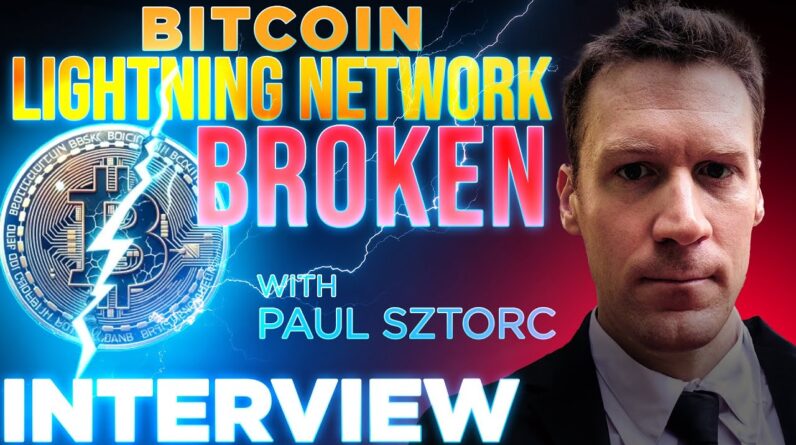
Are you looking for insights into the current state of the Bitcoin Lightning Network? Have you been wondering if it is truly broken? Join us as we delve into the world of BTC Layer-Two’s and get expert opinions from Paul Sztorc. Discover the rankings, challenges, and potential solutions in this thought-provoking blog post. Get ready to explore the turbulent realm of the Bitcoin Lightning Network and unveil the truth behind its operations.
Bitcoin Lightning Network is BROKEN! w/ Paul Sztorc 🔥BTC Layer-Two’s Ranked
Introduction
In the world of cryptocurrencies, Bitcoin remains the undisputed leader. Its decentralized nature, secure infrastructure, and growing adoption have made it the go-to digital currency for millions of people worldwide. However, Bitcoin’s scalability has always been a topic of concern. In an attempt to address this issue, the Bitcoin Lightning Network was introduced as a layer-2 solution to facilitate faster and cheaper transactions. However, recent developments have highlighted significant security risks associated with the Lightning Network, leaving the Bitcoin community uncertain about its future.
The Broken State of the Lightning Network
According to Antoine Riard, a prominent developer, the Bitcoin Lightning Network poses a major security risk. This risk could potentially put funds at stake, thereby jeopardizing the entire purpose of the Lightning Network. This revelation has brought forth an essential flaw in Bitcoin’s layer-2 projects, raising questions about their reliability and long-term viability. It is important to note that these security concerns are not limited to the Lightning Network alone but have broader implications for layer-2 projects within the Bitcoin community.
Limited Growth and Security Concerns
The Lightning Network, which was anticipated to revolutionize Bitcoin payments, has experienced limited growth in recent times. This lack of progress has raised concerns among users and developers alike. Failed Bitcoin payments have become increasingly common, undermining confidence in the scalability and usability of the Lightning Network. This scenario has urged the community to explore alternative solutions that can address these security concerns and enable seamless Bitcoin transactions.
Competition in the Bitcoin Ecosystem
In the Bitcoin ecosystem, there is fierce competition among different payment chains. As layer-2 projects strive to gain dominance, the security risks associated with the Lightning Network have become more concerning. This competition has created a need for comprehensive evaluation and ranking of Bitcoin’s layer-2 projects to assess their security, scalability, and overall reliability. Without proper scrutiny, users may be left vulnerable to potential attacks and losses.
Challenges of Micro-Payments
Micro-payments have always been a challenge for Bitcoin and its layer-2 solutions like the Lightning Network. The limited capacity of the network poses difficulties in processing small transactions efficiently. Michael Saylor, a prominent figure in the cryptocurrency world, has also acknowledged the challenges faced in implementing micro-payments on the Lightning Network. These obstacles further accentuate the security concerns surrounding Bitcoin’s layer-2 projects.
An Alternative: The Drivechain Proposal
In response to the broken state of the Lightning Network, the Drivechain proposal has emerged as a potential alternative. Developed by Paul Sztorc, the Founder and CEO of LayerTwo Labs, Drivechain aims to address the scalability and security concerns of layer-2 solutions. By providing a decentralized and secure platform for Bitcoin transactions, Drivechain offers a fresh perspective on solving the existing issues within the Bitcoin ecosystem.
Ranking Bitcoin’s Layer-Two Projects
As the debate about Bitcoin’s layer-2 solutions intensifies, it becomes crucial to rank and evaluate these projects objectively. This ranking would enable users and developers to make informed decisions about which layer-2 solution to use based on their specific requirements. It would also encourage further research and development to refine and strengthen the security of Bitcoin’s layer-2 projects.
Conclusion
The revelation of major security risks within the Bitcoin Lightning Network has triggered concern among users and developers. The limited growth and failing payments have highlighted the broken state of the Lightning Network, urging the Bitcoin community to explore alternative solutions. The Drivechain proposal and the need to rank Bitcoin’s layer-2 projects signal a collective effort to address the ongoing security concerns and pave the way for more secure Bitcoin transactions in the future.
FAQs (Frequently Asked Questions)
-
Q: What is the Bitcoin Lightning Network?
- The Bitcoin Lightning Network is a layer-2 protocol that aims to facilitate faster and cheaper transactions on the Bitcoin network.
-
Q: What security risks are associated with the Lightning Network?
- According to developer Antoine Riard, the Lightning Network has a major security risk that can potentially endanger funds being transferred through it.
-
Q: Why is the Lightning Network considered “broken”?
- The Lightning Network has experienced limited growth and frequent payment failures, leading to concerns about its overall reliability and scalability.
-
Q: What is the Drivechain proposal?
- The Drivechain proposal, developed by Paul Sztorc, offers an alternative solution to the Lightning Network, addressing the security and scalability concerns of layer-2 projects.
-
Q: Why is ranking Bitcoin’s layer-2 projects important?
- Ranking Bitcoin’s layer-2 projects enables users and developers to make informed decisions, assess security risks, and encourage further research and improvement within the Bitcoin ecosystem.


![THESE BITCOIN WHALES JUST FOOLED EVERYONE! [Exact strategy....]](https://www.cryptocurrents.net/wp-content/uploads/2024/08/these-bitcoin-whales-just-fooled-everyone-exact-strategy-WhgubJxMmeA-796x445.jpg)

![WARNING: EVERY BITCOIN BEAR WILL BE LEFT CRYING [Huge chart.....]](https://www.cryptocurrents.net/wp-content/uploads/2024/08/warning-every-bitcoin-bear-will-be-left-crying-huge-chart-jgadWvvgEJw-796x445.jpg)

